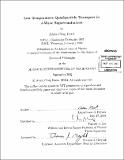| dc.contributor.advisor | Patrick A. Lee. | en_US |
| dc.contributor.author | Durst, Adam Craig, 1974- | en_US |
| dc.contributor.other | Massachusetts Institute of Technology. Dept. of Physics. | en_US |
| dc.date.accessioned | 2005-10-14T19:45:30Z | |
| dc.date.available | 2005-10-14T19:45:30Z | |
| dc.date.copyright | 2002 | en_US |
| dc.date.issued | 2002 | en_US |
| dc.identifier.uri | http://hdl.handle.net/1721.1/29305 | |
| dc.description | Thesis (Ph. D.)--Massachusetts Institute of Technology, Dept. of Physics, 2002. | en_US |
| dc.description | Includes bibliographical references (p. 120-124). | en_US |
| dc.description.abstract | Experiments have now established that the order parameter (gap) in the high-Tc cuprate superconductors exhibits d-wave symmetry, vanishing at four nodal points on the Fermi surface. Near each of these four gap nodes, quasiparticles are easily excited and behave more like massless relativistic particles than electrons in a metal. In this thesis, we study the transport properties of these nodal quasiparticles, providing theoretical interpretations for the results of low temperature thermal and (microwave) electrical transport experiments in the cuprates. We begin by considering the very low temperature regime in which transport is dominated by quasiparticles induced by the very presence of impurities. This is known as the universal limit because prior calculations indicate that the transport coefficients obtain universal (scattering-independent) values. We improve upon prior results by including the contribution of vertex corrections and find that while the electrical conductivity obtains a scattering-dependent correction, the thermal and spin conductivity maintain their universal values. | en_US |
| dc.description.abstract | (cont.) We then focus on the microwave electrical conductivity and consider the slightly higher temperature regime where quasiparticles are excited thermally. Since measurements in detwinned samples yield results that are inconsistent with simple models of impurity scattering, we hypothesize that line defects, remnant from the process of removing twin boundaries, may provide an additional scattering mechanism. We calculate the self-energy and microwave conductivity due to line defect scattering and obtain results that agree well with experiment. Finally, we turn on a magnetic field and consider thermal transport in the mixed (vortex) state. In the weak-field regime, the thermal conductivity tensor can be expressed in terms of the cross section for quasiparticle scattering from a single vortex. We calculate this cross section and thereby obtain both the longitudinal thermal conductivity and the thermal Hall conductivity in surprisingly good qualitative agreement with the measured data. The transparent nature of our calculation allows us to obtain a physical understanding of the features seen in experiments. | en_US |
| dc.description.statementofresponsibility | by Adam Craig Durst. | en_US |
| dc.format.extent | 124 p. | en_US |
| dc.format.extent | 6344161 bytes | |
| dc.format.extent | 6343969 bytes | |
| dc.format.mimetype | application/pdf | |
| dc.format.mimetype | application/pdf | |
| dc.language.iso | eng | en_US |
| dc.publisher | Massachusetts Institute of Technology | en_US |
| dc.rights | M.I.T. theses are protected by copyright. They may be viewed from this source for any purpose, but reproduction or distribution in any format is prohibited without written permission. See provided URL for inquiries about permission. | en_US |
| dc.rights.uri | http://dspace.mit.edu/handle/1721.1/7582 | |
| dc.subject | Physics. | en_US |
| dc.title | Low temperature quasiparticle transport in d-wave superconductors | en_US |
| dc.type | Thesis | en_US |
| dc.description.degree | Ph.D. | en_US |
| dc.contributor.department | Massachusetts Institute of Technology. Department of Physics | |
| dc.identifier.oclc | 52567611 | en_US |
